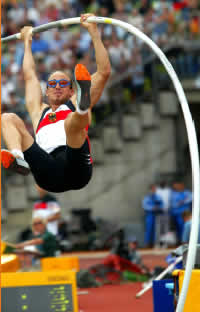Potential Energy
If an object is being pulled by some force, and if you want to move that object, then you are going to have to fight against that force in order to move the object. You will have to do work. For many types of external force, you can get that work back if, after moving the object, you simply let go. For example, if you fight against gravity to lift a shoe from the floor and hold it over your head, and then you let go, the show will fall back to the ground. Before you let go of the object, we say that the work you did was stored as potential energy. Once you let go, the object will zoom back to its starting point, and the work that you did will be manifest as the kinetic energy of the object when it returns to its starting point. If you get all the work back (essentially meaning that there was no friction or other process "stealing" energy and converting it to heat) then we say the force is a conservative force.
Gravity is a conservative force, as is the electrical force that charges exert on each other. Elastic forces (like springs and rubber bands) are not usually conservative, but often there is so little friction that we can pretend that they are to a good approximation.
to do as you read
Gravitational Potential Energy is the work done in lifting a mass from some reference level to its current location. Sideways motion doesn't matter, because you don't have to fight against gravity to move an object sideways. The force you need to lift an object (at constant velocity) is its weight, m·g. Since only vertical distance matters, rather than using "d" for distance, we are going to call the distance "h", for "height". So the work done lifting an object of mass m and height h is...
Example What is the gravitational potential energy of a cow carcass (m=630 kg), flung from a catapult, when it is 25 meters above the ground. Use the ground as the reference level.
1. What is the gravitational potential energy of a 747-200 airliner (mass 250,000 kg) when flying at 11,000 meters above the ground?
2. How much gravitational potential energy does a 1 kg mass have when located 1 meter above the ground?
Elastic Potential Energy is the work done in stretching, compressing or bending a spring, rubber band, or other elastic material.
Old clocks and watches didn't use electicity, but were instead powered by a spiral spring inside. A human would have to wind up the spring, storing elastic potential energy, and as the spring was allowed to slowly unwind it would move the gears and hands. That would last up to a couple days, but then a person would have to wind up the spring again by turning a knob or key.
Bows, crossbows, catapults, and slingshots all use elastic potential energy to launch a projectile. So does a pole-vaulting pole, except that the projectile is a human.

.jpg)

Electrical Potential Energy is the work done in separating opposite charges (positive and negative) or in forcing together like charges (positive and positive, or negative and negative.) It is related to voltage, which you may have heard of before. We won't say anything more about this now, but will when we get to the unit on electricity.